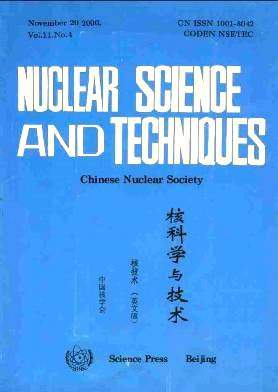Synchrotron radiation X-ray scattering is a useful tool for structural characterization of liquid interfaces. Specular reflectivity provides precise measurement of the interfacial widths and of the ordering of surfactants adsorbed to these interfaces. Diffuse scattering gives information on phase transitions and domain formation in surfactant monolayers and on interfacial fluctuations confined by and coupled across fluidic films.
Vol.17, No.6
Select issueYearIssue
778
SYNCHROTRON TECHNOLOGY AND APPLICATIONS
Research article 20 Dec 2006
LI Ming,Mark L. SCHLOSSMAN
keyword:Synchrotron radiation;Liquid interfaces;X-ray scattering;
Research article 20 Dec 2006
JI Kai
By using a path-integral theory, the photoemission spectra of the electron-phonon (e-ph) coupled systems are calculated exactly. The spectral properties of the e-ph coupled systems based on the 1D and 2D Holstein models are systematically studied under various conditions. The electronic band structure is found to be greatly modified by the multiple scattering effect of electron with phonons, so as to produce a spectral evolution from broad Gaussian at band bottom to two-headed Lorentzian near the Fermi energy. This evolution reflects a transition of electronic states from localized incoherent one to the extended coherent one near the Fermi energy. The results qualitatively agree with recent experiments of high resolution ARPES on the Be (0001) surface and Bi2Sr2CaCu2O8.
keyword:Synchrotron radiation;Angle-resolved photoemission spectroscopy;Electron-phonon interaction;
Research article 20 Dec 2006
ZHU Pei-Ping,HUANG Wan-Xia,YUAN Qing-Xi,YU Jian,WANG Jun-Yue,ZHENG Xin,SHU Hang,CHEN Bo,LIU Yi-Jin,LI En-Rong,WU Zi-Yu
In the first part of this article a more general DEI equation was derived using simple concepts. Not only does the new DEI equation explain all the problems that can be done by the DEI equation proposed by Chapman, but also explains the problem that can not be explained with the old DEI equation, such as the noise background caused by the small angle scattering reflected by the analyzer. In the second part, a DEI-PI-CT formula has been proposed and the contour contrast caused by the extinction of refraction beam has been qualitatively explained, and then based on the work of Ando's group two formulae of refraction CT with DEI method has been proposed. Combining one refraction CT formula proposed by Dilmanian with the two refraction CT formulae proposed by us, the whole framework of CT algorithm can be made to reconstruct three components of the gradient of refractive index.
keyword:Synchrotron radiation;Diffraction enhanced imaging;Refraction computed tomography;
Research article 20 Dec 2006
WATANABE Makoto
The basic concept of synchrotron radiation beamlines for vacuum ultraviolet and X-ray experiments has been introduced to beginning users and designers of beamlines. The beamline defined here is composed of a front end, pre-mirrors, and a monochromator with refocusing mirrors, which are connected by beam pipes, providing monochromatic light for the experiments. Firstly, time characteristics of the synchrotron radiation are briefly reviewed. Secondly, the basic technology is introduced as the fundamental knowledge required to both users and designers. The topics are photoabsorption by air and solids, front ends and beam pipes, mirrors, monochromators, and filters. Thirdly, the design consideration is described mainly for the designers. The topics are design principle, principle of ray tracing, optical machinery and control, and vacuum. Fourthly, polarization control is considered. The topics are polarizers, polarization diagnosis of beamline, and circularly-polarized light generation. Finally, a brief summary is given introducing some references for further knowledge of the users and the designers.
keyword:Synchrotron radiation;Vacuum ultraviolet;X-ray;Beamline;Polarization;
Research article 20 Dec 2006
WEI Shi-Qiang,SUN Zhi-Hu,PAN Zhi-Yun,ZHANG Xin-Yi,YAN Wen-Sheng,ZHONG Wen-Jie
X-ray absorption fine structure (XAFS) has experienced a rapid development in the last three decades and has proven to be a powerful structural characterization technique nowadays. In this review, the XAFS basic principles including the theory, the data analysis, and the experiments have been introduced in detail. To show its strength as a local structure probe, the XAFS applications in semiconductors are summarized comprehensively, that is, thin films, quantum wells and dots, dilute magnetic semiconductors, and so on. In addition, certain new XAFS-related techniques, such as in-situ XAFS, micro-XAFS, and time-resolved XAFS are also shown.
keyword:Synchrotron radiation;X-ray absorption fine structure (XAFS);Local structures;Semiconductor quantum system;
Research article 20 Dec 2006
Masami ANDO,Anton MAKSIMENKO,Tetsuya YUASA,Eiko HASHIMOTO,Katsuhito YAMASAKI,Shu IHIHARA,Hiroshi SUGIYAMA,Tokiko ENDO,LI Gang,CHEN Zhihua,Kazuyuki HYODO,Ei UENO
Ductal carcinoma in-situ (DCIS) has been visualized by 2D XDFI (X-ray dark-field imaging) and further by a 3D X-ray CT, and the data was acquired by the X-ray optics DEI (diffraction-enhanced imaging). A newly made algorithm was used for CT. Data of 900 projections with interval of 0.2 degrees were used. Ductus lactiferi, microcalcification in a 3D form have been clearly visible. The spatial resolution available was approximately 30 μm.
keyword:Synchrotron radiation;X-ray dark-field imaging (XDFI);Ductal carcinoma in-situ (DCIS);Diffraction-enhanced imaging (DEI);Microcalcification;3D CT;Vertical wiggler;X-ray refraction;Monochrocollimator;



